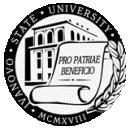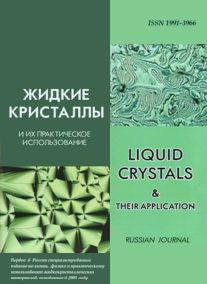|

|
Liquid Crystals and their Application
Russian Journal Zhidkie kristally i ikh prakticheskoe ispol'zovanie Жидкие кристаллы и их практическое использование |

|
|

|

|
|
|
Menu

|
|
|
|
|
Zhidk. krist. ikh prakt. ispol'z. = Liq. Cryst. and their Appl., 2019, 19 (2), 76—84.
DOI: 10.18083/LCAppl.2019.2.76 |

|
|
Correlation between Structural and Tribological Characteristics of Some Mesomorphic Boundary Lubrication Layers
|
O. V. Blinov1, V. A. Godlevskiy2, Yu. N. Moiseev3, A. S. Parfenov4
|
Author affiliations
1Ivanovo State Polytechnical University,
21 Sheremetevsky Ave., Ivanovo, 153000, Russia
2Ivanovo State University,
39 Ermak St., Ivanovo, 153025, Russia
E-mail: godl@yandex.ru
3Ivanovo Rescue and Fire Fighting Academy of the State Fire Service,
33 Stroiteley Ave., Ivanovo, 153040, Russia
4Ivanovo State Medical Academy,
8 Sheremetevsky Ave., Ivanovo, 153012, Russia
|
|
Abstract
The article is devoted to the epitropic orderliness of mesogenic lubrication material in boundary layer. The modelling of tribo-system with boundary lubrication layer by means of management of the software realizing methods of the molecular mechanics, quantum chemistry and molecular dynamics has been carried out. During modelling the virtual lubrication layer of the designated thickness with randomized initial molecules arrangement was built. Further procedure included the minimization of molecular system energy by corresponding optimization of molecules orientation in the lubrication layer. Modelling solid surfaces of friction took place at a certain distance in parallel to each other. The lubricant was placed between these surfaces. The value of lubricant’s molecular cluster orientation factor was counted in the process of iteration of periodic virtual shear of the top surface relative to bottom and consequent optimization process taking into account an arrangement of molecules concerning surfaces.
Tests of some lubrication substances which molecules possessed anisometric form and, hence, propensity to supramolecular self-organizing in the lubricant layer have been conducted. For comparison of experimental results, the correlation dependence between modeling and experiment was built. It confirms the reliability of molecular modeling data for prediction of antifrictional properties of mesogenic lubricating materials.
Keywords: boundary lubrication layer, epitropic phase, mesogen, molecular modeling, molecular dynamics, lubricant, friction coefficient, correlation
|
|
|
|
|
|




